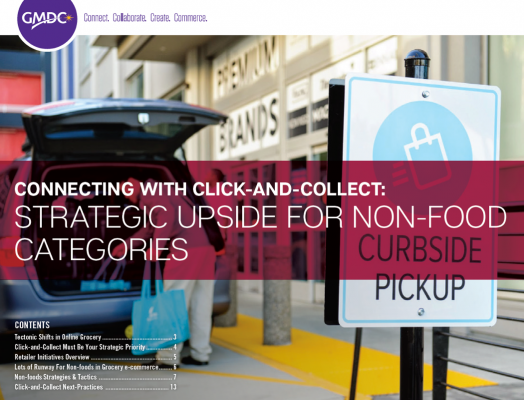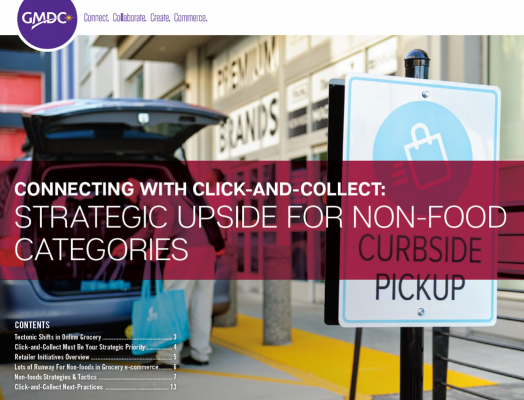

GMDC’s latest research shares why non-food manufacturers should not fear click-and-collect, but embrace it as an emerging high-growth channel opportunity – or be left outside the basket
Global Market Development Center (GMDC), an association that connects its members to advance innovation in the marketplace, examines why non-food manufacturers should embrace click-and-collect rather than fear it in its latest next practice report: Connecting with Click-and-Collect: Strategic Upside for Non-Categories.
As the grocery industry increasingly pushes online and some of the biggest retailers ramp up click-and-collect models, what the future might hold is making many a bit jittery, especially for non-food, center-store categories. And while online grocery sales could exceed $100 billion by 2025 – with click-and-collect generating $6.6 billion of CPG sales per year by 2020 according to an IRI study – non-foods manufacturers that embrace click-and-collect as an emerging high-growth channel opportunity, stand to increase sales possibilities.
“Non-food categories have long been recognized as basket-building categories for the retail grocery industry. In other words, they help drive in-store transaction size and build margin. No one – manufacturer or retailer – wants to lose these benefits as a result of the click-and-collect movement,” said GMDC’s Director of Research, Industry Insights & Communications, Mark Mechelse.
In contrast to fresh and frozen foods, where brick-and-mortar stores are the preferred shopping destination, non-foods and HBC are seeing double-digit sales growth online, up 19.4 percent and 17.9 percent respectively from 2015 to 2016 according to Nielsen Homescan data cited by Acosta in its report Bricks & Clicks – Understanding the Omni Channel Landscape. General merchandise isn’t far behind, registering 8.7 percent year-over-year growth online during the same time period.
To succeed and embrace this digital movement, non-food retailers and manufacturers must rewire their go-to-market strategies by working together to develop seamless, integrated strategies and plans that breed profitability, growth and success for all involved parties. “As retailers move swiftly into the uncharted territory of click-and-collect, one thing is certain: supplier partnerships must be deepened to successfully navigate digital transformation, manage shopper expectations, and effectively create a positive outcome for all trading partners,” said Patrick Spear, GMDC president and CEO.
Non-Food Strategies & Tactics
 Ordering: Planned, Prompted & Replenishable: Whether the shopping trip is happening online or offline, the first course of business for any product or brand is to get on a shopper’s grocery list.
Ordering: Planned, Prompted & Replenishable: Whether the shopping trip is happening online or offline, the first course of business for any product or brand is to get on a shopper’s grocery list.
“Manufacturers should work with retail customers to make it easy to find products on the site by monitoring keyword search and optimize product descriptions and detail pages so items are easy to find. Menu placement and ease of navigation is important for full-basket retailers that tend to mimic supermarket aisles,” said Keith Anderson, vice president of strategy and insights at Profitero, and lead author of the whitepaper for GMDC.
Profitero also suggests that creating in-cart suggestions similar to strategic cross-merchandising display execution inside brick-and-mortar stores, manufacturers should work with retailers to create cross-display opportunities online. Virtual bundling and cross-merchandising is another effective tactic. Unlike in a physical store, merchandise bundles needn’t be physically co-packed.
Collection & Post-Collection: The collection point itself represents another prime opportunity to make the non-foods sale. Innovative approaches and out-of-the-box thinking will be required to add product displays, deploy digital advertising/promotions or other new technologies to capture shopper attention for non-foods goods.
“The good news is that we only have a small handful of large vendors today that do one-third of our business,” said Spencer Baird ,SVP Merchandising, B2B & Pick-up at PeaPod. “This means we can get to a lot more depth in our planning with them and find ways to create mutual value for our customer and the vendor. We will also partner closely with a group of smaller vendors. We’re not wed to the old ‘scale trumps all’ mentality because if you look at where our business over-indexes, in many cases it is on smaller, more progressive areas in nutrition or health sometimes, progressive is in the bag of smaller manufacturers.”
Next Practices
What steps can be taken or action plans devised by non-grocery suppliers to meet the challenges and opportunities head on to enable a positive outcome? GMDC offers the following click-and-collect next practices.
- Since 69 percent of shoppers who use click-and-collect buy additional GM/HBW items, extend the technology platform to begin suggesting meal items and additional food-item purchasing with complementary non-foods.
- Create impulse displays or other POP materials near the point of pickup to increase sales.
- Place more non-food items on the first page of the click-and-collect site. When searching for items online, consumers have a propensity to not click through to the second and third pages.
- Leverage geo-fencing technology to know when the consumer is near the store or ready to pickup their order.
Partners and supporters whose contributions have made the report possible are Newell Brands, Big Time Products, Melita and RugDoctor. Insight providers include Profitero, IRi , Acosta and Nielsen.
Click here to download the video report. The executive summary and other next practices can be found here.


























